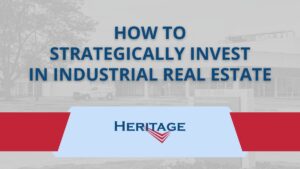In our world of industrial real estate investment, we are fundamentally in the business of renting out our money. It is a concept that encapsulates the essence of what we do—we are always seeking to earn a 'rent' on our capital, expecting it to work as diligently for us as we do in managing it.
This is not just about leasing space; it is about how much more we aim to make beyond a risk-free return to justify tying up our funds in non-liquid assets. Our decisions are guided by a balance between immediate income potential and the long-term growth of our investments. We often find ourselves asking, "What rent (return) do we want to receive for our money?"
Through careful consideration and strategic planning, we strive for that perfect deal where returns come from both dividends and growth—where half of our reward is realized through current income and the other half through appreciation over time. Every property tells a story of economic principles at play, where timelines are not just measured but meticulously crafted, and where preservation of capital is always Rule Number One.
Our next investment is under contract. Please join the waitlist for priority access when the deal goes live.
We Rent Our Money
For all of us – whether it is we here at Heritage or the person next door – we are engaged in this process of renting out our capital. When our money is tied up and illiquid, there is an expectation of a certain return on investment, akin to a rent factor for utilizing that money. We are constantly evaluating various opportunities where we can rent out our funds. We are investing to generate income, and the ability to growth that income. It boils down to striking a balance between risk and reward, safety and liquidity.
Typically, within the industry, people refer to the ten-year Treasury note as a benchmark for this 'rent,' seeing it as the risk-free rate against which other investments are compared. There is plenty of nuanced discussion around whether using the ten-year Treasury as a risk-free standard is appropriate or if indeed it carries no risk at all. These discussions are vital because they shape how we view economics and investing in real estate, particularly within in the industrial and other asset classes we invest in.
Finding That Sweet Spot
The government and various financial instruments come into play when we talk about where to allocate our resources. Ultimately, it is a question of how much return we seek above what is considered the risk-free alternative – typically, the treasuries. As a point of reference, consider where interest rates were towards the end of 2023 at around 4%. This poses an essential query for us: how much more do we need to earn to justify the illiquidity and additional risks associated with real estate investment?
If we can secure a 4% return with virtually no risk and complete liquidity through treasuries, we must determine how much higher the 'rent' for our money should be to make real estate an attractive option. Historically, this premium has been in the range of 3 to 4% above treasury rates. Therefore, we are looking at a desired annual return of around 7 to 8% to make it worthwhile.
However, there are various perspectives on this matter. The form in which returns are received – whether through dividends or capital growth – also plays a significant role in decision-making. Some investors might prefer immediate income streams while others might opt for growth potential on the back end; some may look for a combination of both.
Ultimately, our investment decisions hinge on where we feel comfortable renting out our money compared to other safe avenues available for investment. It is about personal thresholds for risk versus reward and finding that sweet spot where the potential gains outweigh the inherent risks and illiquidity of real estate investments.
In The Money (Business)
In considering deals, there is a delicate balance between immediate income potential – current pay or immediate yield – and the long-term possibility of value growth in an asset. This introduces a perspective of time and income that must be weighed carefully.
Industry professionals often utilize Internal Rate of Return (IRR) to measure deals. There is a saying that 'you can't eat IRR,' highlighting that while IRR measures efficiency or quality of investments to compare to alternatives, actual returns are in dollars.
The timing of these payments can significantly affect the IRR; receiving payment upfront versus later on can result in vastly different IRRs even if the total return is identical. Essentially, this underscores the principle that a dollar today is more valuable than one tomorrow.
For Heritage, if we had to craft an ideal investment scenario, it would involve an arrangement or targeted calculation/balance where half our returns come from dividends and half from growth. This setup allows us to be paid while waiting – essentially earning rent on our capital currently while also benefiting from future appreciation.
A Focus on the Future
We are always contemplating the balance between current returns and future growth potential. Imagine a scenario where we invest $1 million in a property that yields 7% annually. Five to ten years down the line, we sell it for exactly what we paid. Our downside in such a case is making that consistent 7% each year – essentially, the rent on our money.
Now, if we compare this to another deal promising an annualized 7% return contingent on selling the property at a significant markup after five years, although the projected return might be the same, the risk profiles are entirely different. The latter carries higher risk because it lacks those yearly dividends; it is all predicated on future sale price appreciation.
While we would ideally like to see an even split between immediate income and growth potential—50/50—that is not always attainable due to market imperfections. Sometimes we might only get a third of our returns from current dividends. A rule of thumb is that high current returns often suggest limited upside potential – there is less room for growth if you are already reaping substantial rewards upfront. Conversely, lower current returns should indicate greater prospects for value appreciation down the line.
As for minimum thresholds when greenlighting deals, we look for opportunities that offer around a 7% current cash flow return leveraged after accounting for all expenses. And beyond just these initial returns, there should be room for rent escalation and compound growth contributing to long-term profit.
Acquisition is arguably the most challenging aspect in our industry; securing valuable real estate is far more arduous than selling it. Once you have made a purchase, selling is not always desirable given how difficult it can be to find comparable investment opportunities again. This underscores why a balanced approach to immediate income versus long-term growth is not just preferred but necessary when considering which deals to pursue in real estate investing.
The Art of Risk Management
The outlook for the economy, the market we are investing in, and anticipated growth also significantly influence our decisions. For instance, deals in New York City might accept lower rates due to higher expected growth. It is important to remember that our approach has never been about zero immediate return with all gains deferred five years down the line; we prefer to get paid rent along the way.
Protection of capital is paramount – it is our Number One Rules: do not lose money.
That is why even if we sell a property for what we paid after ten years but have collected consistent returns annually, we have safeguarded our initial investment. Ensuring capital safety against unforeseen 'black swan' events and being set up to weather them is part of this principle.
To protect capital effectively involves being conservative with debt levels, choosing properties in good locations and stable industries. Risk assessment is more an art than a science; it is not just about quantifying risk into percentages but having a holistic understanding based on comfort levels with particular assets or markets.
Multiples of capital are another vital metric that goes beyond IRR; doubling our money is often an initial benchmark for success in an investment. The key question is not just if we will double our money but when – how long will it take? Doubling our investment within five years translates to roughly a 15% IRR; doing so within three years equates to about a 20% IRR. These rules of thumb help gauge an investment's potential success over time and are integral to evaluating both preservation of capital and analysis of risk.
Moreover, understanding concepts like the rule of 72 can provide additional insight into how quickly investments can grow, further informing our strategies for balancing immediate yields with long-term appreciation while always prioritizing capital protection first and foremost.
Understanding The Rule of 72
The Rule of 72 is a straightforward yet powerful tool we use to gauge investment growth. It helps us understand how long it will take for our money to double at a given interest rate. For instance, at a 10% return, an investment doubles in about 7.2 years. In contrast, with a 7.2% return, it would take ten years to double.
Leverage also plays a key role in our calculations. With 65% leverage and 35% equity in a deal, the property's value only needs to increase by 35%, not 100%, for our equity to double. This is the goal: increase the value of the property by one-third—because that is what we have put in—and simultaneously get paid along the way.
While doubling our money is not necessarily a checkbox item for every deal we consider, it is certainly a fundamental part of our underwriting process. We aim for conservative projections; we might underwrite for a 1.8 multiple knowing that holding the asset just one more year could bump that up to two times the initial investment.
The idea is to aim high but plan conservatively so that reality outperforms projections due to conservative underwriting and positive surprises—the upside surprise factor. The best deals historically have provided both current returns and opportunities to double equity within 5 to 7 years, possibly through capital transactions or financing events such as sales with tax-deferred exchanges like Section 1031.
Getting paid current dividends allows investors like us to enjoy ongoing income while letting economic forces work their magic alongside professional experience and inflation's impact on value over time. And we cannot overlook construction costs—owning property at a lower basis becomes increasingly valuable as new construction prices rise over time; replacement costs exceed what you initially paid for your existing property.
Ultimately, what we are betting on is time—the greatest maker of wealth there is. Our job involves narrowing down that timeline as much as possible without sacrificing potential gains or taking on undue risk. Even modest compounding rates can lead to significant appreciation over extended periods—proof positive to the power of time and incremental growth in creating wealth through industrial real estate investing.
Our Most Successful Deals
Reflecting on the deals that have been most successful for our firm, they all share a common theme: a solid current yield combined with the potential to double our investment. One such example is a warehouse we invested in outside Cincinnati, Ohio. When we acquired it, the leveraged return was around 8%. However, we recognized that the leases were at below market rates; tenants were paying $3 per square foot when the going rate was closer to $5.
We anticipated that one of the tenants would vacate since they were constructing another building nearby. This gave us a two-year window to market the soon-to-be-available space. Our conservative underwriting accounted for possibly picking up an additional $2 per square foot on just a portion of the building as our upside. The unexpected happened—a year into our ownership, there was an early vacancy and subsequent bidding war for the space, which resulted in us re-leasing the entire building at $7 per square foot, far exceeding our initial projections.
This kind of upside surprise exemplifies conservative underwriting and setting realistic expectations—it is about being okay with an acceptable outcome while remaining open to greater possibilities. We still own this property continuing to reap the benefits from this investment.
Deliberate Planning, Patient Investing
As we wrap up this conversation about renting our money, it is clear that timelines play a significant role in our underwriting process. The question of how long to hold an investment is esoteric indeed, but also pragmatic. We consider both macro and micro decisions when determining the ideal timing for each property.
Macro-level thinking suggests that the longer we hold an investment, the better it performs due to the use of money and other factors. On a micro level, it comes down to executing a business plan for a particular building and assessing when it has reached its peak value.
However, we could also choose to retain properties and let time work in our favor as an investor. There is no singular right or wrong answer; it is about what feels right for each specific deal given current circumstances, partner dynamics, and personal considerations.
While there is no strict 'ideal' hold period, we often find ourselves holding deals in that 5 to 7-year range. This is not due to any formulaic approach but rather because real estate takes time to enter and exit—a quick turnaround would be 18 months, which is rare and usually not by design.
For instance, a property we bought in Bozeman, Montana was intended for renovation and re-leasing. However, just 18 months later, we sold it at an 80% return due to an unexpected opportunity with the county government needing space adjacent to their courthouse renovation project. That capital was then reinvested into another promising property yielding around 7% with below-market rents.
Renting our money is about more than just allocating funds—it is about strategic planning over time while considering economic conditions and potential opportunities. It requires patience, foresight, which sometimes forms the basis of a bit of luck. What remains constant is the imperative of understanding the underlying reasons behind each investment decision we make.



